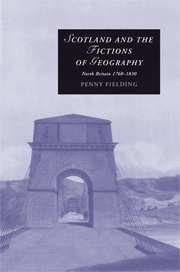Book contents
- Frontmatter
- Contents
- Acknowledgements
- Introduction
- 1 North Britain
- 2 Burns, place and language
- 3 Great North Roads: The geometries of the nation
- 4 Antiquarianism and the inscription of the nation
- 5 Ultima Thule: The limits of the north
- 6 Norths: James Hogg and post-Enlightenment space
- Notes
- Bibliography
- Index
- CAMBRIDGE STUDIES IN ROMANTICISM
2 - Burns, place and language
Published online by Cambridge University Press: 05 May 2010
- Frontmatter
- Contents
- Acknowledgements
- Introduction
- 1 North Britain
- 2 Burns, place and language
- 3 Great North Roads: The geometries of the nation
- 4 Antiquarianism and the inscription of the nation
- 5 Ultima Thule: The limits of the north
- 6 Norths: James Hogg and post-Enlightenment space
- Notes
- Bibliography
- Index
- CAMBRIDGE STUDIES IN ROMANTICISM
Summary
James Currie, the biographer and first editor of Robert Burns, associates the distinctive character of Scottish song with a sense of place:
Many of the love-songs of Scotland describe scenes of rural courtship; many may be considered as invocations from lovers to their mistresses. On such occasions a degree of interest and reality is given to the sentiments, by the spot destined to these happy interviews being particularized. The lovers perhaps meet at the Bush aboon Traquair, or on the Banks of Etrick; the nymphs are invoked to wander among the wilds of Roslin, or the woods of Invermay.
Currie's juxtaposition of ‘interest’ (the application of a personal feeling) and ‘reality’ (the recognition of an external condition) introduces an idea that highlights the unstable nature of Romantic place as he suggests that the local may not just be familiar and thus specific to those who live there, but may also exemplify familiarity itself as a general principle. Although it was unlikely that most British readers in 1800 had much empirical acquaintance with the banks of Ettrick, the fact that songs may be set there confers on them, according to Currie, a sense of ‘reality’. This in turn calls up the position of North Britain within Great Britain: on the one hand, Scotland is geographically other, a place of curiosity to inspire the external reader's ‘interest’, while, on the other, Scottish places are imbued with the universal inner ‘reality’ of nature that underpins the social organisation of modern Britain through sensibility and neoclassicism: ‘these rustic bards […] are guided by the same impulse of nature and sensibility which influenced the father of epic poetry.’
- Type
- Chapter
- Information
- Scotland and the Fictions of GeographyNorth Britain 1760–1830, pp. 40 - 70Publisher: Cambridge University PressPrint publication year: 2008
- 1
- Cited by

